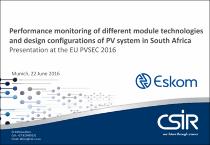 ResearchSpace
ResearchSpace
Performance monitoring of different module technologies and design configurations of PV system in South Africa
JavaScript is disabled for your browser. Some features of this site may not work without it.
- ResearchSpace
- →
- Research Publications/Outputs
- →
- Conference Publications
- →
- View Item
| dc.contributor.author |
Roro, Kittessa T

|
|
| dc.date.accessioned | 2016-10-03T08:13:23Z | |
| dc.date.available | 2016-10-03T08:13:23Z | |
| dc.date.issued | 2016-06 | |
| dc.identifier.citation | Roro, K.T. 2016. Performance monitoring of different module technologies and design configurations of PV system in South Africa. In: EU PVSEC 2016, 22 June 2016, Munich | en_US |
| dc.identifier.uri | http://www.eupvsec-planner.com/presentations/c37203/performance_monitoring_of_different_module_technologies_and_design_configurations_of_pv_systems_in_south_africa.htm | |
| dc.identifier.uri | http://hdl.handle.net/10204/8771 | |
| dc.description | EU PVSEC 2016, 22 June 2016, Munich | en_US |
| dc.description.abstract | Performance monitoring of different module technologies and system configurations of Photovoltaic (PV) systems in South Africa is rare, resulting in-few reports based on field results of PV systems installed and operated in South Africa. The goal of this work is to analyse the performance of PV systems, evaluate the energy output of various PV system configurations and module technologies in the South African climatic conditions. To achieve this, a 400 kWp PV Solar plant has been installed and monitored since January 2015 at the Research and Development Centre of ESKOM in Rosherville, Gauteng. The plant consists of polycrystalline silicon (c-Si) and copper indium gallium selenide (CIGS) thin film technologies. The plant comprises of two 25° fixed north facing inclination, north-south single axis tracking and two 10° fixed shed orientation each for both module technologies. The analysis was conducted for duration of 1 year. The evaluation is achieved by studying the operation of PV plant under different weather conditions and the impact of different configurations and technologies on systems overall output, and performance ratio was calculated. The CIGS module technology performed better than c-Si technology in both fixed north facing and tracking configurations when considering specific or final yield. The study provides an insight to identify the optimal configuration and suitable PV technology for deployment of solar photovoltaic system in South Africa. The monitored data and operating experience of PV system can be applied for future projects. | en_US |
| dc.language.iso | en | en_US |
| dc.publisher | EU PVSEC | en_US |
| dc.relation.ispartofseries | Workflow;17274 | |
| dc.subject | Photovoltaic (PV) systems | en_US |
| dc.subject | PV systems performance | en_US |
| dc.title | Performance monitoring of different module technologies and design configurations of PV system in South Africa | en_US |
| dc.type | Conference Presentation | en_US |
| dc.identifier.apacitation | Roro, K. T. (2016). Performance monitoring of different module technologies and design configurations of PV system in South Africa. EU PVSEC. http://hdl.handle.net/10204/8771 | en_ZA |
| dc.identifier.chicagocitation | Roro, Kittessa T. "Performance monitoring of different module technologies and design configurations of PV system in South Africa." (2016): http://hdl.handle.net/10204/8771 | en_ZA |
| dc.identifier.vancouvercitation | Roro KT, Performance monitoring of different module technologies and design configurations of PV system in South Africa; EU PVSEC; 2016. http://hdl.handle.net/10204/8771 . | en_ZA |
| dc.identifier.ris | TY - Conference Presentation AU - Roro, Kittessa T AB - Performance monitoring of different module technologies and system configurations of Photovoltaic (PV) systems in South Africa is rare, resulting in-few reports based on field results of PV systems installed and operated in South Africa. The goal of this work is to analyse the performance of PV systems, evaluate the energy output of various PV system configurations and module technologies in the South African climatic conditions. To achieve this, a 400 kWp PV Solar plant has been installed and monitored since January 2015 at the Research and Development Centre of ESKOM in Rosherville, Gauteng. The plant consists of polycrystalline silicon (c-Si) and copper indium gallium selenide (CIGS) thin film technologies. The plant comprises of two 25° fixed north facing inclination, north-south single axis tracking and two 10° fixed shed orientation each for both module technologies. The analysis was conducted for duration of 1 year. The evaluation is achieved by studying the operation of PV plant under different weather conditions and the impact of different configurations and technologies on systems overall output, and performance ratio was calculated. The CIGS module technology performed better than c-Si technology in both fixed north facing and tracking configurations when considering specific or final yield. The study provides an insight to identify the optimal configuration and suitable PV technology for deployment of solar photovoltaic system in South Africa. The monitored data and operating experience of PV system can be applied for future projects. DA - 2016-06 DB - ResearchSpace DP - CSIR KW - Photovoltaic (PV) systems KW - PV systems performance LK - https://researchspace.csir.co.za PY - 2016 T1 - Performance monitoring of different module technologies and design configurations of PV system in South Africa TI - Performance monitoring of different module technologies and design configurations of PV system in South Africa UR - http://hdl.handle.net/10204/8771 ER - | en_ZA |





